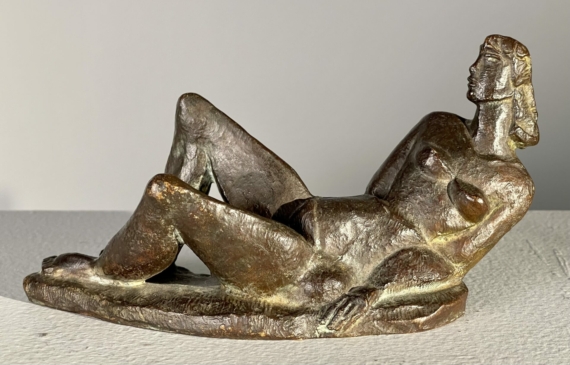
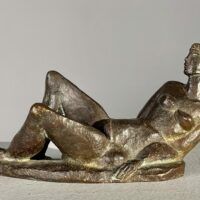
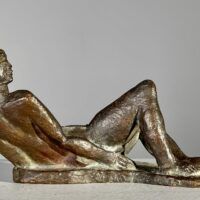
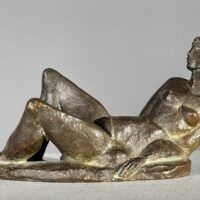
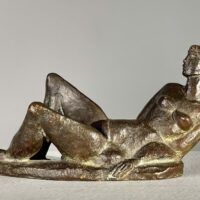

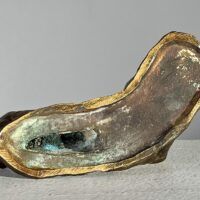
Robert Laurent
American, 1890-1970
Reclining Figure, c. 1950
Bronze, dark brown patina
4 H. x 8 W. inches
Inscribed: “LAURENT”
Robert Laurent was an American artist best known for his modernist figurative sculpture, though he is also notable for his work in printmaking and teaching. The New York Times wrote that his work “figured in the development of an American sculptural art that balanced nature and abstraction.”
Born the son of French peasants in Concarneau, Brittany, France in 1890, Laurent was first discovered by art critic, painter, and collector Hamilton Easter Field after the Brooklyn Eagle recognized his work. Field visited Laurent’s village to paint and subsequently hosted Laurent and his family in his New York City home for three years, becoming a mentor and father figure to Laurent. In 1908, Laurent accompanied Field on a trip to Rome, where he trained with Maurice Sterne. He then studied drawing at the British Academy and became an apprentice to a framemaker. Laurent moved to America in 1910 only to quickly return to Europe to fight with the navy in World War I. After the war ended, he made frames for Childe Hassam and Robert Henri before transitioning into carving reliefs.
Field died in 1922 and left Laurent his entire estate, including his Brooklyn home, his art collection, and the Ogunquit Summer School of Graphic Arts, which they had co-founded. Laurent also mounted his first solo exhibition in 1922 at the Bourgeois Gallery in New York. Later in the 1920s, Laurent began working with bronze and experimenting with printmaking. Inspired by French sculptor Gaston Lachaise, he became interested in the female nude as a subject. Throughout the 1930s, he completed commissions for public sculptures at Radio City Music Hall in New York City, Fairmount Park in Philadelphia, and the Federal Trade Building in Washington, D.C.
Laurent is widely credited as the first American sculptor to adopt the style of “direct carving”, in which the sculptor works without the use of intermediate models, typically from memory. This leads to bolder and more abstract pieces such as Reclining Figure (c. 1950). Laurent was inspired by African carving and European avant-garde art, though he was also influenced by folk styles from America and medieval stone cutters from his native French region of Brittany. His techniques encouraged American sculptors to explore beyond traditional fine arts practices.
In 1938, Laurent won the Logan Prize at the Art Institute of Chicago’s annual American art exhibition. He won the Audubon Sculpture Award in New York in 1945 and was named sculptor in residence at the American Academy in Rome in 1954. He was also one of 23 American sculptors featured in the controversial American National Exhibition in Moscow in 1959.
In addition to his artistic pursuits, Laurent also had a great career in academia, teaching at the Art Students League in New York City, the Corcoran Gallery of Art in Washington, D.C., Vassar College, Goucher College, and Indiana University. Laurent taught sculpture and wood carving at the Ogunquit Summer School of Graphic Arts every season for 50 years.
Laurent also held many administrative positions as a fellow of the National Sculpture Society, president of the Hamilton Easter Field Foundation, and a member of the Sculptor’s Guild. He was elected to the National Institute of Arts and Letters shortly before his death in 1970.